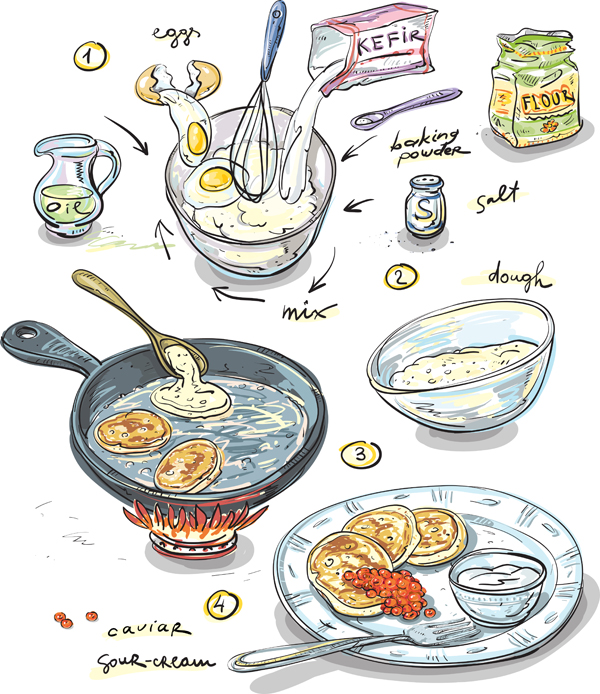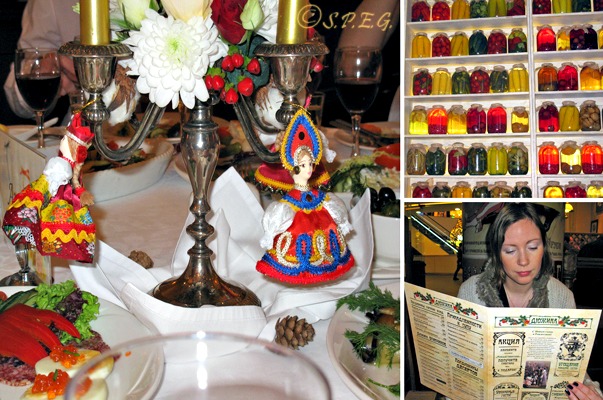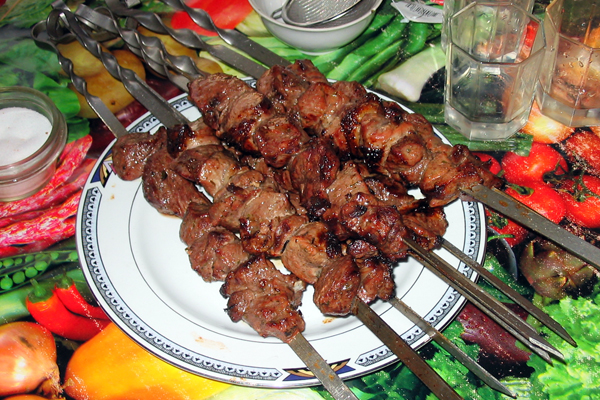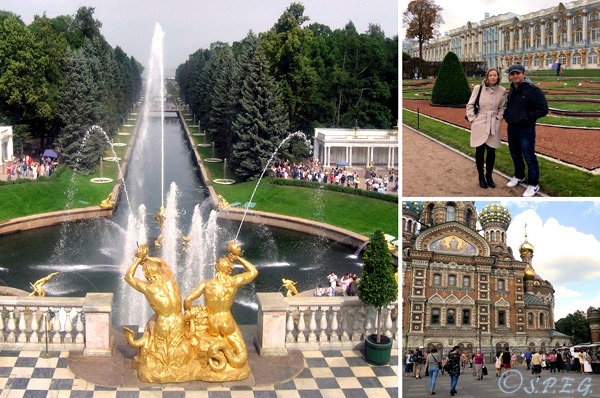Russian Cuisine
An Introduction to the History
and Food of russia!
Russian Cuisine formed in northern climes, where the main requirements of food were that it be high in calories, easy to digest, and simple to prepare. Find out more!
Russian cuisine is perhaps, one of the most diverse and colorful in the world. Its varied quality arrives from the vast and multi-cultural area of Russia. It was formed by the peasant farmer of the rural population in an often harsh and northern climate condition, where the main requirements of food were that it be high in calories, easy to digest and simple to prepare.
Above all Russian people valued
the freshness of the basic ingredient, its healthy and natural taste, which they strove to enhance and not stifle with
seasonings. This still remains one
of the cardinal virtues of Russian cuisine today, making each dish a
special masterpiece of culinary art. But, it was not always like this. Its evolution was long and original as we tell you below.
As Russia’s borders expanded southward and eastward, the traditional cooking style adopted dishes from the peoples of the Volga basin, Siberia, and the Caucasus, where each nation had its own specialty. Since then they all started to borrow recipes and cooking techniques from each other in order to boost the variety of dishes available today.
It is interesting to know that Russian cuisine has always welcomed foreign recipes.
In fact, Russians learned to cook yeast dough from Scythians and Greeks. They knew about rice, buckwheat, and many spices from Byzantium. The tea came to Russia from China. Bulgaria shared with Russia the sweet peppers, eggplants, and zucchini. Western Slavs gave to Russian cuisine beetroot and beef-based soup known as Borsch, stuffed cabbage rolls named Golubtsi and boiled dumplings stuffed with vegetables or sweet fillings the so-called Vareniki.
That's why Russian food is diverse and more than just pancakes, cabbage, caviar, and vodka. You should know that the very notion of Russian food has changed a lot in the last century. The dishes in Russia now are very different from the ones cooked in the old times. They're well presented, abundant, varied, and tasty. So, if you'll travel to Russia, make sure you book a table in a local restaurant.
ALL ABOUT RUSSIAN CUISINE
Want to know more about Russian Cuisine? If you would like to learn more please keep reading below. To get started just click on the links below to fast track to that section. Happy reading!
Quick Links:
HISTORY OF RUSSIAN CUISINE
Modern Russian cuisine reached the top of its evolution a little more than a hundred years ago, in the second half of the 19th-century. However, before this, it went through several stages.
Russian cuisine started a real development in the 16th century. Although many recipes have been lost and no exact documents survived, many made it through centuries such as famous Bliny (pancakes) and cherniy hleb (rye bread). The 17th-century history – conquering of Kazan and Astrakhan, Bashkiria and Siberia - brought Pelmeni (dumplings) to the Russian cuisine.

The 18th-century was the time of Franco-Russian cuisine, when aristocracy started employing foreign chefs. That is when famous Russian home-made sausages, T-bone steaks, cutlets came into existence, and dishes became lighter with less fat and wheat.
That was also the time when still famous dishes such as Beef Stroganoff and Chicken Kiev were introduced.
Soviet times brought colorful variety to food as 15 different republics shared recipes, which again enriched the Russian cuisine and introduced many more spices and ingredients.
In time, Russian cuisine became more sophisticated and delicate. The variety of recipes is growing every day and today eating in Russia is an exciting and joyful experience everyone should try.
THE ORIGIN FROM 9TH TO 16TH CENTURY
At the beginning the basic dishes on the tables of ancient Russians were bread, farinaceous products and grain-based meals. Women used to bake bliny (pancakes), rye pies, and to boil flour-based fool. Not a single family celebration could do without delicious pastry foodstuffs. They baked kurnik (today a Russian chicken pie) for the wedding, bliny, and pirogi (pies) for the annual folk holiday Maslenitsa.
Pies were stuffed with fish, meat, poultry, mushrooms, berries, cheese, vegetables, fruits, and even kasha. All guests were usually greeted with round caraway (loaf of bread) and salt. Caravay was set in the center of the table at every feast.
Kasha in Russia was very popular at that time, as it is still today, while milk and meat were not so popular until the 17th-century. Despite this, milk was consumed in a raw way and then baked or soured. While sour milk was used for making curd cheese and sour cream, the production of cream and butter had remained practically unknown until the 16th- century.
Vegetables such as cabbage, turnip, radish, peas, and cucumbers were also normally eaten raw or salted, sometimes steamed or boiled as well as baked separately from one another.
Instead, honey and berries in ancient times were the basis for syrups and preserves, and when it was mixed with flour, butter, eggs, the beloved honey, and berries became the foundation of Russian national dessert – the so-called Pryaniki.
During the medieval period most Russian beverages such as cider, mead, khmel, and kvass became national, while the beer came into life only in 1284 and the famous Russian vodka made from rye grain, appeared only in 1440-1470 centuries.
THE LARGE DEVELOPMENT IN 17TH CENTURY
Russian cuisine absorbed the best of what existed in the kitchens of the European countries in the 16th - 18th centuries: salads and green vegetables, smoked foods, chocolate, ice cream, wine, liquor, sugar, coffee, and much more.
Under Peter the Great the word «soup» entered the Russian language; before that all liquid dishes were called “Pokhlyobka” a name, similar to the one of William Vasilyevich Pokhlyobkin, an old famous Russian author of numerous culinary books. Soups were served in ceramic or iron pots to be eaten only with wooden spoons.
Even potatoes appeared in Russia thanks to Peter the Great who brought them from Europe and later contributed to the spread of this plant in the central regions of Russia. Potatoes and soups and other types of food were served in ceramic or iron pots and also eaten only with wooden spoons.
Russian cuisine was also introduced to “Oriental” dishes such as noodles and Pelmeny borrowed from Asian cuisines, although this was years later than the vast traditional Russian food.
During this time most Russian people were eating roast meat, poultry, and game with beef, used for corned beef and pork turned into roasted ham, sometimes also fried and stewed. Alongside the much-eaten meat dishes, Russian soups like the popular Solyanka containing brine, lemons and olives, started to appear on the table.
It was in this period that such well-known delicacies as black caviar, salted and jellied fish turned up.
In the 16th-century Kazan and Astrakhan Khanates along with Bashkiria and Siberia were incorporated into the Russian territory. This event increased hugely the growth of the Russian food. But according to Russian History, only the 17th-century seems to have marked the highest development of Russian cuisine.
FROM 18TH TO 19TH CENTURY
The current peculiarity of St. Petersburg Cuisine can be explained only if we look into the city’s capital status and its proximity to Europe. If today the city of St Petersburg has a large variety of food, it is primarily due to the will and interest of Tsar Peter I who imported French, German, Dutch, and Italian dishes.
In fact history tells us that from the time of Peter the Great and Catherine the Great Russian nobility borrowed West European culinary customs and traditions.
Rich nobles, who visited Western Europe, were so impressed and delighted that they brought with them foreign chefs to Russia, thus making a huge contribution to the development of Russian cuisine. It was at this time that minced meat was introduced into the Russian cooking style: chops, casserole, pates, rolls became quite popular along with non-Russian (Swedish, German, French) soups (dairy, vegetable).
Naturally the foreign chefs cooked not Russian but their own national dishes, which now fit harmoniously into the cuisine of Russia.
French chefs introduced delicacies and sauces into the diet of the nobility. The tradition of fried meat came from Holland. Some of the dishes that are considered Russian such as Beef stroganoff, Chicken Kiev and Apple Charlotte, actually appeared as a result of the French and Austrian chefs. There was also the time of German sandwiches, butter, French and Dutch cheeses.
Needless to say, Russian cuisine was influenced not only from neighboring countries but also from the predominant Orthodox religion, which in turn strongly influences all aspects of the lives of the Russian people as well as traditional Russian food.
In fact, in the past, due to the old fasting rule of the Russian Orthodox Church (a teaching rule not widely known or followed these days), Russians for up to 220 days per year were required to eat only vegetarian food. This has favored the gradual appearance of many vegetarian and vegan soups, appetizers, main courses, and desserts with a variety of fish dishes and caviar.
RUSSIAN CUISINE TODAY
Despite all the changes caused by foreign chefs the basics of Russian cuisine remained intact for centuries.
In fact, it managed to preserve the most characteristic national features like the abundance of food on the table, a range of starters, loyalty to bread, Bliny, kashas; plus and not limited to that, originality of first liquid cold and hot meals with a variety of fish, vegetables, and mushrooms dishes as well as a vast choice of sweet stuffs like jams, cookies, gingerbreads, cakes and so on.
Russians generally love meat because starvation for most of the old generation meant having no bread, while poverty meant going without hard sausage. Hence, sausage, pork, beef, mutton, chicken, and dried or salted fish are widely available and relatively cheap. But unfortunately only the wealthy class today can afford to buy delicacies such as veal, duck, sturgeon, and salmon.
Russian Cuisine today is one of the most popular and widely spread in the world with some dishes being considered classics of world culinary heritage. Origins of this cuisine as well as a historical foreign influence have been constantly introducing new culinary techniques. These have opened the doors to creative combinations of varied ingredients, culinary, and seasoning techniques with the traditional Russian dishes.
Russian food is often defined as elegant and highly nuanced, and many of the Russian dishes that you may find in modern cuisine have actually been developed through centuries with a lot of historical influence. Notwithstanding, the whole classic native food has remained the standard for the vast majority of Russians well into the 20th-century.
Despite many stereotypes, the modern cuisine of Russia has a lot more to offer, from hundreds of soups, meat, and fish recipes to delicious sweets and bakery. Today Russian food not only represents Slavic food, but also consists of many recipes cooked by more than 150 nationalities living in Russia.
For your information, only in Saint Petersburg you can find over 4000 restaurants and cafes serving not only a great variety of hearty and tasty Russian dishes but also an international varied cuisine for any kind of palate.☺
RUSSIAN ETIQUETTE
Russian etiquette today has slightly evolved into more contemporary etiquette, fitting the European standard. But it all depends on who you will deal with: the younger generation has more modern habits than the older generation.
Travelers for the first-time may experience culture shock after seeing Russian behavior. For example, Russians never smile at strangers. They smile for things that they find amusing or for greeting friends and colleagues. But if you were invited to a Russian home expect a lot of smiles from the hosts and other guests.
When visiting a Russian's home, visitors should note that hands are not shaken until the visitor has passed the threshold of the door frame. Guests should always remove their shoes immediately upon entering their host's home. Slippers are usually given immediately to guests to wear, so don’t be afraid that your feet will get cold or soiled.☺
If you are invited for dinner, a small edible gift (wine, chocolates, fruit) should always be given to hosts.
They are especially happy if you bring them some souvenir or food specialty from your home country. If you come to celebrate a birthday or some Russian holiday bring flowers. Remember not to give flowers in even numbers (even-numbered bunches of flowers are reserved for funerals).
People should sit in a way that the soles of their shoes face the floor and never show the soles to Russians. This is considered grave disrespect. Single women should avoid sitting at the corner of a table as this is considered bad luck for them. Russians follow European table manners – a fork in the left hand, a knife in the right hand.
It is also customary for Russians to drink shots of vodka in between meal courses. Vodka is never sipped, always gulped. A little bit of knowledge of the Russian language is very important. At the very least, tourists should learn to say Pazhalsta – “Please” and Spasibo – “Thank You”.
A good tip for all people visiting Saint Petersburg Russia is to ask the locals about Russian customs. In most cases, the locals are happy to share. Anyway, Russians are forgiving when foreigners make mistakes, so no worries.

Hello! We are Davide & Anastasia the founders of st-petersburg-essentialguide.com.☺
We would like to let you know that apart from writing unique content for our travel website we can also help with the arrangement of your Airport Transfer, Private City Tour, and Russian Visa Support, or anything else you may need during your stay or the planning of your trip to St Petersburg Russia. Just get in touch with us today for more info!

From Russian Cuisine return to Russian Food or go to the Homepage
DO YOU LIKE ST PETERSBURG ESSENTIAL GUIDE? HAVE YOU FOUND THIS PAGE HELPFUL?
If you do, please help others to find out about it. If you have a blog or website, or know someone who does, consider linking to us. Share the link on Facebook, Tweet it... you get the idea. Every link helps!






